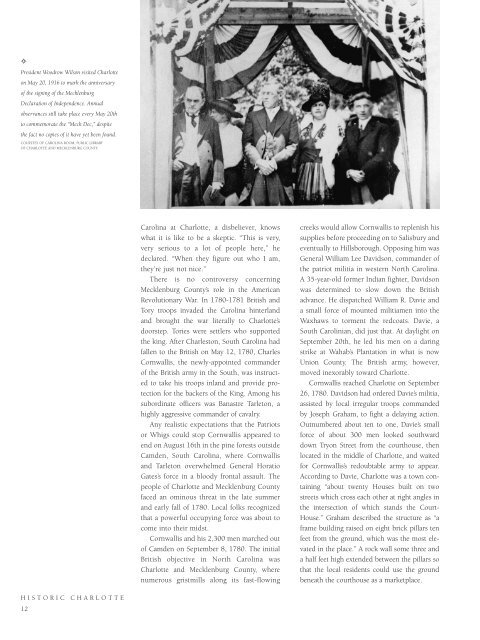Historic Charlotte
An illustrated history of the City of Charlotte and the Mecklenburg County area, paired with the histories of companies, families and organizations that make the region great.
An illustrated history of the City of Charlotte and the Mecklenburg County area, paired with the histories of companies, families and organizations that make the region great.
Create successful ePaper yourself
Turn your PDF publications into a flip-book with our unique Google optimized e-Paper software.
✧<br />
President Woodrow Wilson visited <strong>Charlotte</strong><br />
on May 20, 1916 to mark the anniversary<br />
of the signing of the Mecklenburg<br />
Declaration of Independence. Annual<br />
observances still take place every May 20th<br />
to commemorate the “Meck Dec,” despite<br />
the fact no copies of it have yet been found.<br />
COURTESY OF CAROLINA ROOM, PUBLIC LIBRARY<br />
OF CHARLOTTE AND MECKLENBURG COUNTY.<br />
Carolina at <strong>Charlotte</strong>, a disbeliever, knows<br />
what it is like to be a skeptic. “This is very,<br />
very serious to a lot of people here,” he<br />
declared. “When they figure out who I am,<br />
they’re just not nice.”<br />
There is no controversy concerning<br />
Mecklenburg County’s role in the American<br />
Revolutionary War. In 1780-1781 British and<br />
Tory troops invaded the Carolina hinterland<br />
and brought the war literally to <strong>Charlotte</strong>’s<br />
doorstep. Tories were settlers who supported<br />
the king. After Charleston, South Carolina had<br />
fallen to the British on May 12, 1780, Charles<br />
Cornwallis, the newly-appointed commander<br />
of the British army in the South, was instructed<br />
to take his troops inland and provide protection<br />
for the backers of the King. Among his<br />
subordinate officers was Banastre Tarleton, a<br />
highly aggressive commander of cavalry.<br />
Any realistic expectations that the Patriots<br />
or Whigs could stop Cornwallis appeared to<br />
end on August 16th in the pine forests outside<br />
Camden, South Carolina, where Cornwallis<br />
and Tarleton overwhelmed General Horatio<br />
Gates’s force in a bloody frontal assault. The<br />
people of <strong>Charlotte</strong> and Mecklenburg County<br />
faced an ominous threat in the late summer<br />
and early fall of 1780. Local folks recognized<br />
that a powerful occupying force was about to<br />
come into their midst.<br />
Cornwallis and his 2,300 men marched out<br />
of Camden on September 8, 1780. The initial<br />
British objective in North Carolina was<br />
<strong>Charlotte</strong> and Mecklenburg County, where<br />
numerous gristmills along its fast-flowing<br />
creeks would allow Cornwallis to replenish his<br />
supplies before proceeding on to Salisbury and<br />
eventually to Hillsborough. Opposing him was<br />
General William Lee Davidson, commander of<br />
the patriot militia in western North Carolina.<br />
A 35-year-old former Indian fighter, Davidson<br />
was determined to slow down the British<br />
advance. He dispatched William R. Davie and<br />
a small force of mounted militiamen into the<br />
Waxhaws to torment the redcoats. Davie, a<br />
South Carolinian, did just that. At daylight on<br />
September 20th, he led his men on a daring<br />
strike at Wahab’s Plantation in what is now<br />
Union County. The British army, however,<br />
moved inexorably toward <strong>Charlotte</strong>.<br />
Cornwallis reached <strong>Charlotte</strong> on September<br />
26, 1780. Davidson had ordered Davie’s militia,<br />
assisted by local irregular troops commanded<br />
by Joseph Graham, to fight a delaying action.<br />
Outnumbered about ten to one, Davie’s small<br />
force of about 300 men looked southward<br />
down Tryon Street from the courthouse, then<br />
located in the middle of <strong>Charlotte</strong>, and waited<br />
for Cornwallis’s redoubtable army to appear.<br />
According to Davie, <strong>Charlotte</strong> was a town containing<br />
“about twenty Houses built on two<br />
streets which cross each other at right angles in<br />
the intersection of which stands the Court-<br />
House.” Graham described the structure as “a<br />
frame building raised on eight brick pillars ten<br />
feet from the ground, which was the most elevated<br />
in the place.” A rock wall some three and<br />
a half feet high extended between the pillars so<br />
that the local residents could use the ground<br />
beneath the courthouse as a marketplace.<br />
HISTORIC CHARLOTTE<br />
12
















